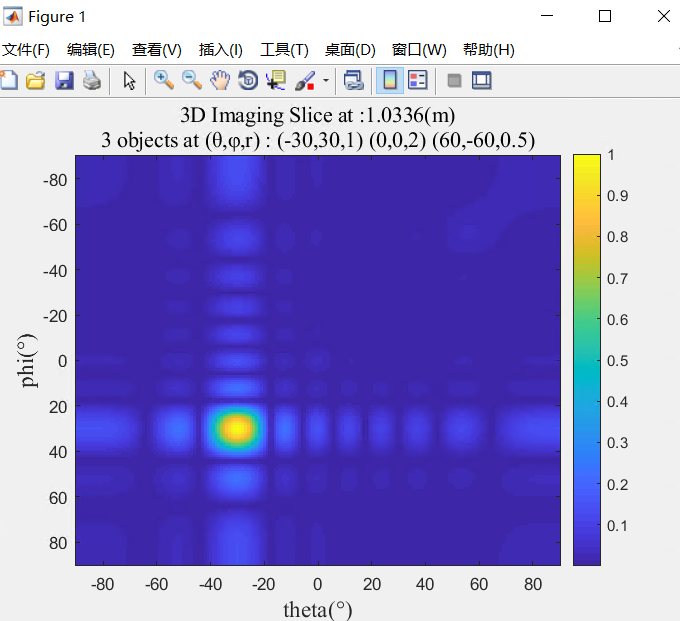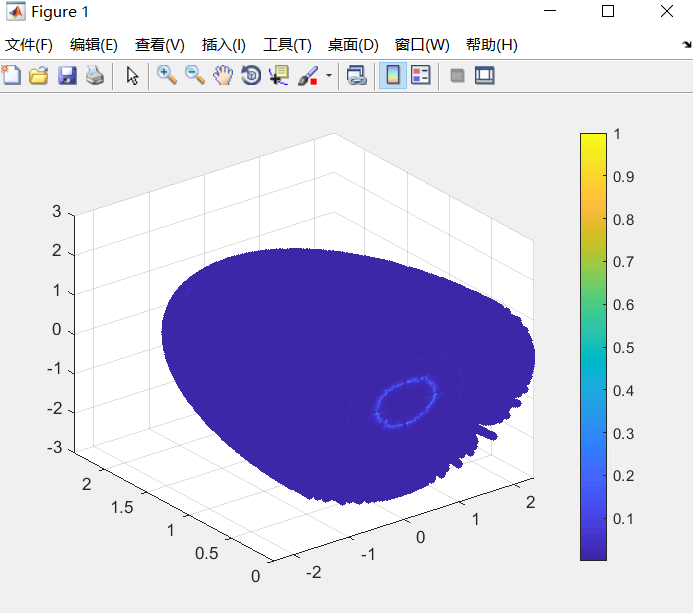2维的热度图 imagesc
imagesc(x, y, z),x和y分别是横纵坐标,z为值,表示颜色
imagesc(theta,phi,slc); colorbar
xlabel('theta(°)','fontname','Times New Roman','FontSize',14);
ylabel('phi(°)','fontname','Times New Roman','FontSize',14);
sta = '3 objects at (θ,φ,r) : (-30,30,1) (0,0,2) (60,-60,0.5)';
str=sprintf(strcat('3D Imaging Slice at :', num2str(d_max*D/N), '(m)', '
',sta));
title(str, 'fontname','Times New Roman','Color','k','FontSize',13);
grid on

其中,colorbar的坐标值调整:caxis([0 1]);
colormap的色系调整:colormap hot
3维散点图 scatter
scatter3(x,y,z,24,c,'filled'); % axis([-(R+2) (R+2) -(R+2) (R+2) 0 (h+2)]); colorbar

2维 极坐标热度图 polarPcolor
polarPcolor(R_axis, theta, value),前两个为半径方向坐标轴和圆心角坐标轴,value为值,用颜色表示
[fig, clr] = polarPcolor(R_axis, theta, x_d_th, 'labelR','range (m)','Ncircles', 5,'Nspokes',7); colormap hot % caxis([0 1]);

其中polarPcolor代码如下:
function [varargout] = polarPcolor(R,theta,Z,varargin)
% [h,c] = polarPcolor1(R,theta,Z,varargin) is a pseudocolor plot of matrix
% Z for a vector radius R and a vector angle theta.
% The elements of Z specify the color in each cell of the
% plot. The goal is to apply pcolor function with a polar grid, which
% provides a better visualization than a cartesian grid.
%
%% Syntax
%
% [h,c] = polarPcolor(R,theta,Z)
% [h,c] = polarPcolor(R,theta,Z,'Ncircles',10)
% [h,c] = polarPcolor(R,theta,Z,'Nspokes',5)
% [h,c] = polarPcolor(R,theta,Z,'Nspokes',5,'colBar',0)
% [h,c] = polarPcolor(R,theta,Z,'Nspokes',5,'labelR','r (km)')
%
% INPUT
% * R :
% - type: float
% - size: [1 x Nrr ] where Nrr = numel(R).
% - dimension: radial distance.
% * theta :
% - type: float
% - size: [1 x Ntheta ] where Ntheta = numel(theta).
% - dimension: azimuth or elevation angle (deg).
% - N.B.: The zero is defined with respect to the North.
% * Z :
% - type: float
% - size: [Ntheta x Nrr]
% - dimension: user's defined .
% * varargin:
% - Ncircles: number of circles for the grid definition.
% - Nspokes: number of spokes for the grid definition.
% - colBar: display the colorbar or not.
% - labelR: legend for R.
%
%
% OUTPUT
% h: returns a handle to a SURFACE object.
% c: returns a handle to a COLORBAR object.
%
%% Examples
% R = linspace(3,10,100);
% theta = linspace(0,180,360);
% Z = linspace(0,10,360)'*linspace(0,10,100);
% figure
% polarPcolor(R,theta,Z,'Ncircles',3)
%
%% Author
% Etienne Cheynet, University of Stavanger, Norway. 28/05/2016
% see also pcolor
%
%% InputParseer
p = inputParser();
p.CaseSensitive = false;
p.addOptional('Ncircles',5);
p.addOptional('Nspokes',8);
p.addOptional('labelR','');
p.addOptional('colBar',1);
p.parse(varargin{:});
Ncircles = p.Results.Ncircles ;
Nspokes = p.Results.Nspokes ;
labelR = p.Results.labelR ;
colBar = p.Results.colBar ;
%% Preliminary checks
% case where dimension is reversed
Nrr = numel(R);
Noo = numel(theta);
if isequal(size(Z),[Noo,Nrr]),
Z=Z';
end
% case where dimension of Z is not compatible with theta and R
if ~isequal(size(Z),[Nrr,Noo])
fprintf('
')
fprintf([ 'Size of Z is : [',num2str(size(Z)),']
']);
fprintf([ 'Size of R is : [',num2str(size(R)),']
']);
fprintf([ 'Size of theta is : [',num2str(size(theta)),']
']);
error(' dimension of Z does not agree with dimension of R and Theta')
end
%% data plot
rMin = min(R);
rMax = max(R);
thetaMin=min(theta);
thetaMax =max(theta);
% Definition of the mesh
Rrange = rMax - rMin; % get the range for the radius
rNorm = R/Rrange; %normalized radius [0,1]
% get hold state
cax = newplot;
% transform data in polar coordinates to Cartesian coordinates.
YY = (rNorm)'*cosd(theta);
XX = (rNorm)'*sind(theta);
% plot data on top of grid
h = pcolor(XX,YY,Z,'parent',cax);
shading flat
set(cax,'dataaspectratio',[1 1 1]);axis off;
if ~ishold(cax);
% make a radial grid
hold(cax,'on')
% Draw circles and spokes
createSpokes(thetaMin,thetaMax,Ncircles,Nspokes);
createCircles(rMin,rMax,thetaMin,thetaMax,Ncircles,Nspokes)
end
%% PLot colorbar if specified
if colBar==1,
c =colorbar('location','WestOutside');
caxis([quantile(Z(:),0.01),quantile(Z(:),0.99)])
else
c = [];
end
%% Outputs
nargoutchk(0,2)
if nargout==1,
varargout{1}=h;
elseif nargout==2,
varargout{1}=h;
varargout{2}=c;
end
%%%%%%%%%%%%%%%%%%%%%%%%%%%%%%%%%%%%%%%%%%%%%%%%%%%%%%%%%%%%%%%%%%%%%%%%%%%
% Nested functions
%%%%%%%%%%%%%%%%%%%%%%%%%%%%%%%%%%%%%%%%%%%%%%%%%%%%%%%%%%%%%%%%%%%%%%%%%%%
function createSpokes(thetaMin,thetaMax,Ncircles,Nspokes)
circleMesh = linspace(rMin,rMax,Ncircles);
spokeMesh = linspace(thetaMin,thetaMax,Nspokes);
contour = abs((circleMesh - circleMesh(1))/Rrange+R(1)/Rrange);
cost = cosd(90-spokeMesh); % the zero angle is aligned with North
sint = sind(90-spokeMesh); % the zero angle is aligned with North
for kk = 1:Nspokes
plot(cost(kk)*contour,sint(kk)*contour,'k:',...
'handlevisibility','off');
% plot graduations of angles
% avoid superimposition of 0 and 360
if and(thetaMin==0,thetaMax == 360),
if spokeMesh(kk)<360,
text(1.05.*contour(end).*cost(kk),...
1.05.*contour(end).*sint(kk),...
[num2str(spokeMesh(kk),3),char(176)],...
'horiz', 'center', 'vert', 'middle');
end
else
text(1.05.*contour(end).*cost(kk),...
1.05.*contour(end).*sint(kk),...
[num2str(spokeMesh(kk),3),char(176)],...
'horiz', 'center', 'vert', 'middle');
end
end
end
function createCircles(rMin,rMax,thetaMin,thetaMax,Ncircles,Nspokes)
% define the grid in polar coordinates
angleGrid = linspace(90-thetaMin,90-thetaMax,100);
xGrid = cosd(angleGrid);
yGrid = sind(angleGrid);
circleMesh = linspace(rMin,rMax,Ncircles);
spokeMesh = linspace(thetaMin,thetaMax,Nspokes);
contour = abs((circleMesh - circleMesh(1))/Rrange+R(1)/Rrange);
% plot circles
for kk=1:length(contour)
plot(xGrid*contour(kk), yGrid*contour(kk),'k:');
end
% radius tick label
for kk=1:Ncircles
position = 0.51.*(spokeMesh(min(Nspokes,round(Ncircles/2)))+...
spokeMesh(min(Nspokes,1+round(Ncircles/2))));
if abs(round(position)) ==90,
% radial graduations
text((contour(kk)).*cosd(90-position),...
(0.1+contour(kk)).*sind(86-position),...
num2str(circleMesh(kk),2),'verticalalignment','BaseLine',...
'horizontalAlignment', 'center',...
'handlevisibility','off','parent',cax);
% annotate spokes
text(contour(end).*0.6.*cosd(90-position),...
0.07+contour(end).*0.6.*sind(90-position),...
[labelR],'verticalalignment','bottom',...
'horizontalAlignment', 'right',...
'handlevisibility','off','parent',cax);
else
% radial graduations
text((contour(kk)).*cosd(90-position),...
(contour(kk)).*sind(90-position),...
num2str(circleMesh(kk),2),'verticalalignment','BaseLine',...
'horizontalAlignment', 'right',...
'handlevisibility','off','parent',cax);
% annotate spokes
text(contour(end).*0.6.*cosd(90-position),...
contour(end).*0.6.*sind(90-position),...
[labelR],'verticalalignment','bottom',...
'horizontalAlignment', 'right',...
'handlevisibility','off','parent',cax);
end
end
end
end
再贴一个示例代码:
%% Examples % The following examples illustrate the application of the function % polarPcolor clearvars;close all;clc; %% Minimalist example % Assuming that a remote sensor is measuring the wind field for a radial % distance ranging from 50 to 1000 m. The scanning azimuth is oriented from % North (0 deg) to North-North-East ( 80 deg): R = linspace(50,1000,100)./1000; % (distance in km) Az = linspace(0,80,100); % in degrees [~,~,windSpeed] = peaks(100); % radial wind speed figure(1) [h,c]=polarPcolor(R,Az,windSpeed); %% Example with options % We want to have 4 circles and 7 spokes, and to give a label to the % radial coordinate figure(2) [~,c]=polarPcolor(R,Az,windSpeed,'labelR','r (km)','Ncircles',7,'Nspokes',7); ylabel(c,' radial wind speed (m/s)'); set(gcf,'color','w') %% Dealing with outliers % We introduce outliers in the wind velocity data. These outliers % are represented as wind speed sample with a value of 100 m/s. These % corresponds to unrealistic data that need to be ignored. To avoid bad % scaling of the colorbar, the function polarPcolor uses the function caxis % combined to the function quantile to keep the colorbar properly scaled: % caxis([quantile(Z(:),0.01),quantile(Z(:),0.99)]) windSpeed(1:10:end,1:20:end)=100; figure(3) [~,c]=polarPcolor(R,Az,windSpeed); ylabel(c,' radial wind speed (m/s)'); set(gcf,'color','w') %% polarPcolor without colorbar % The colorbar is activated by default. It is possible to remove it by % using the option 'colBar'. When the colorbar is desactivated, the % outliers are not "removed" and bad scaling is clearly visible: figure(4) polarPcolor(R,Az,windSpeed,'colBar',0) ; %% Different geometry 1 N = 360; R = linspace(0,1000,N)./1000; % (distance in km) Az = linspace(0,360,N); % in degrees [~,~,windSpeed] = peaks(N); % radial wind speed figure(5) [~,c]= polarPcolor(R,Az,windSpeed); ylabel(c,' radial wind speed (m/s)'); set(gcf,'color','w') %% Different geometry 2 N = 360; R = linspace(500,1000,N)./1000; % (distance in km) Az = linspace(0,270,N); % in degrees [~,~,windSpeed] = peaks(N); % radial wind speed figure(6) [~,c]= polarPcolor(R,Az,windSpeed,'Ncircles',3); location = 'NorthOutside'; ylabel(c,' radial wind speed (m/s)'); set(c,'location',location); set(gcf,'color','w')